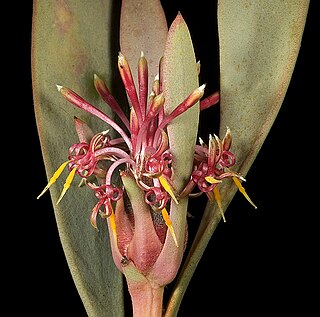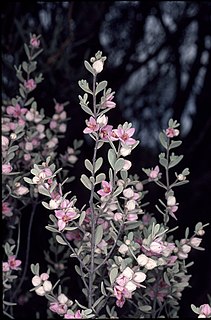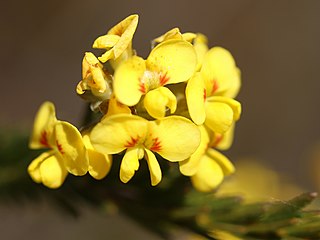Banksia foliolata is a species of shrub that is endemic to Western Australia. It has hairy stems, pinnatifid leaves, heads of about sixty cream-coloured and maroon flowers and oblong to elliptical follicles. It grows on rocky slopes in dense shrubland in the Stirling Range National Park.

Chorilaena quercifolia, commonly known as karri oak or chorilaena, is a species of bushy shrub that is endemic to the karri forests of south-west Western Australia. It is the sole species in the genus Chorilaena. It has papery, broadly egg-shaped leaves with lobed edges and variously-coloured flowers arranged in umbels of five, the sepals and petals hairy on the outside and the stamens protruding beyond the petals.

Dasymalla is a genus of five species of flowering plants in the mint family, Lamiaceae and is endemic to Western Australia. Plants in this genus are woolly shrubs with five petals joined to form a tube-shaped flower with four stamens of unequal lengths. These species are similar to those in the genus Pityrodia except that the fruit does not release its seeds when mature.

Lasiopetalum behrii, commonly known as the pink velvet bush, is a species of flowering plant in the family Malvaceae and is endemic to southern continental Australia. It is an erect shrub with lance-shaped, narrowly oblong to narrowly elliptic leaves and groups of white to pink and reddish-brown flowers.

Eremophila racemosa, also known as showy eremophila, is a flowering plant in the figwort family Scrophulariaceae, and is endemic to Western Australia. It is an erect shrub with glabrous leaves, small, green sepals and flowers that have many colour variations often changing as they age.

Anthotroche is a genus of shrubs in the family Solanaceae. The genus is endemic to Western Australia.

Lasiopetalum baueri, commonly known as slender velvet bush, is a species of flowering plant in the family Malvaceae and is endemic to south-eastern Australia. It is a small, greyish shrub with more or less linear to narrowly oblong or narrowly elliptic leaves and groups of white or pink flowers.

Thomasia macrocarpa, commonly known as large-fruited thomasia, is a shrub that is endemic to the southwest of Western Australia.
Bossiaea nummularia is a species of flowering plant in the family Fabaceae and is endemic to New South Wales. It is a prostrate to low-lying sub-shrub with moderately hairy foliage, mostly broadly elliptic leaves, and yellow and red flowers.

Verticordia roei, commonly known as Roe's featherflower is a flowering plant in the myrtle family, Myrtaceae and is endemic to the south-west of Western Australia. It is a shrub with narrow leaves and is often covered with masses of creamy-white coloured flowers in late spring.
Dasymalla axillaris, commonly known as native foxglove or woolly foxglove, is a flowering plant in the mint family Lamiaceae and is endemic to Western Australia. It is a small, diffuse shrub with its branches, leaves and some of its flower parts densely covered with white, woolly hairs. The flowers are a shade of red and tube-shaped with the stamens and style extending beyond the end of the five petals.

Dasymalla terminalis, commonly known as native foxglove, is a flowering plant in the mint family Lamiaceae and is endemic to the south-west of Western Australia. It is a shrub with its branches, leaves and some of its flower parts densely covered with white, woolly hairs. The leaves are thick and soft and the flowers are tube-shaped, pale to deep pinkish-purple or claret red.

Thryptomene australis, commonly known as hook-leaf thryptomene, is a species of flowering plant in the family Myrtaceae and is endemic to the south-west of Western Australia. It is an erect, bushy and spreading shrub with upward-pointing leaves with the tip curving outwards, and flowers with white petals arranged spike-like near the ends of the branchlets.

Isopogon pruinosus is a species of flowering plant in the family Proteaceae and is endemic to southwestern Western Australia. It is a compact, spreading shrub with narrow egg-shaped leaves with the narrower end towards the base and spherical to elliptic heads of pink flowers.

Boronia ternata is a plant in the citrus family Rutaceae and is endemic to the south-west of Western Australia. It is an erect shrub with many branches, simple or trifoliate leaves and white to pink four-petalled flowers.

Dillwynia elegans is a species of flowering plant in the family Fabaceae and is endemic to eastern New South Wales. It is an erect shrub with more or less cylindrical, grooved leaves and yellow flowers with red markings.

Philotheca linearis, commonly known as the rock wallaby shrub or narrow-leaf wax-flower, is a species of flowering plant in the family Rutaceae and is endemic to an inland areas of southern Australia. It is a shrub with glandular-warty branchlets and leaves, club-shaped to cylindrical leaves and white flowers arranged singly in leaf axils.

Goodenia fasciculata is a species of flowering plant in the family Goodeniaceae and is endemic to the south-west of Western Australia. It an ascending shrub with bunched, narrow linear stem leaves and spikes of white flowers.
Lasiopetalum adenotrichum is a species of flowering plant in the family Malvaceae and is endemic to the Fitzgerald River National Park in the south of Western Australia. It is an erect shrub with hairy foliage, narrow egg-shaped to lance-shaped leaves and groups of white to cream-coloured and dark reddish-purple flowers.
Lasiopetalum angustifolium, commonly known as narrow leaved lasiopetalum, is a species of flowering plant in the family Malvaceae and is endemic to coastal areas of south-western Western Australia. It is a low spreading or dense, compact shrub with narrowly egg-shaped to narrowly elliptic leaves and compact groups of pink to purplish flowers.















